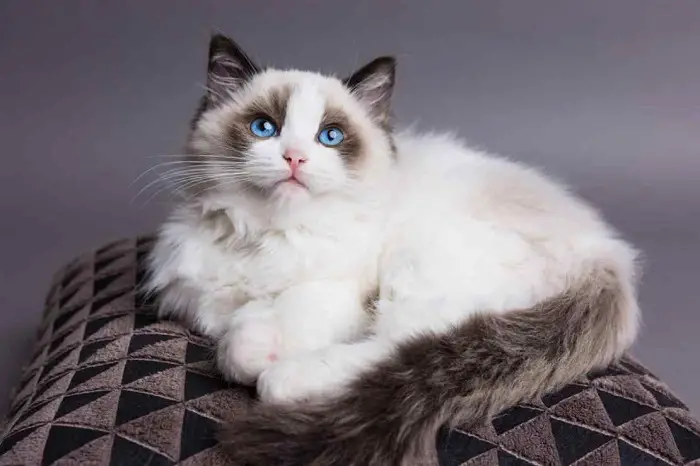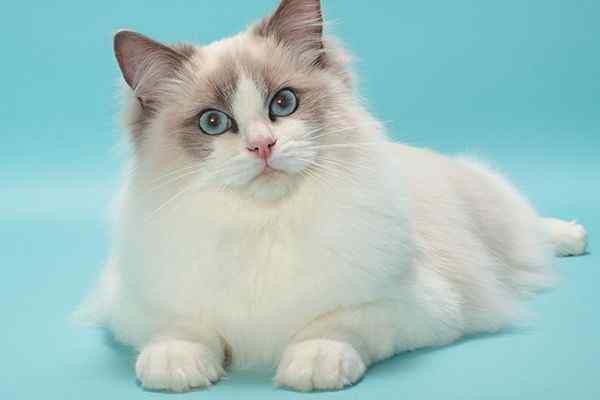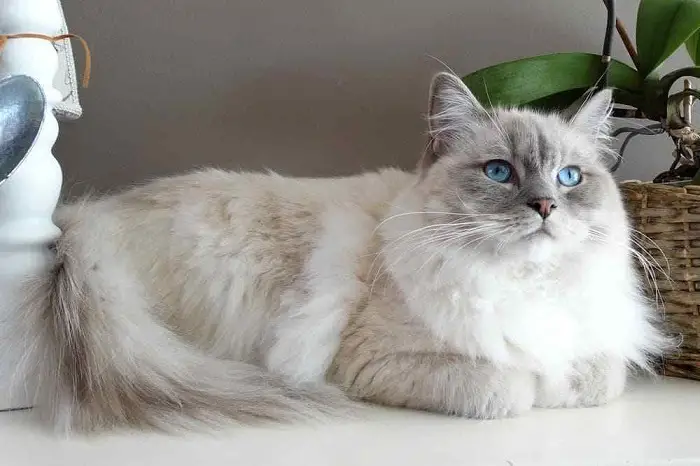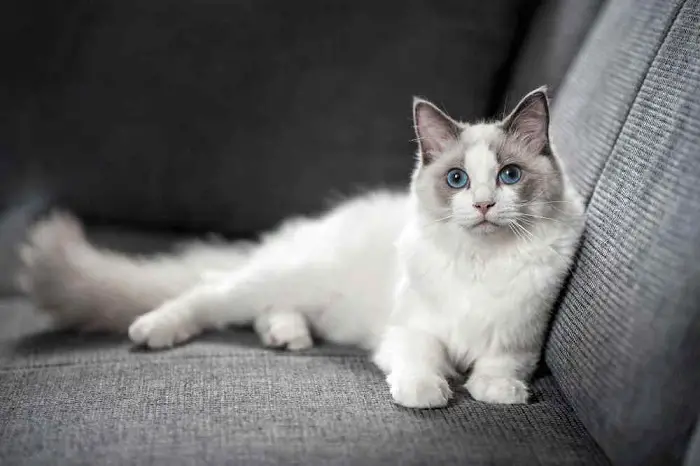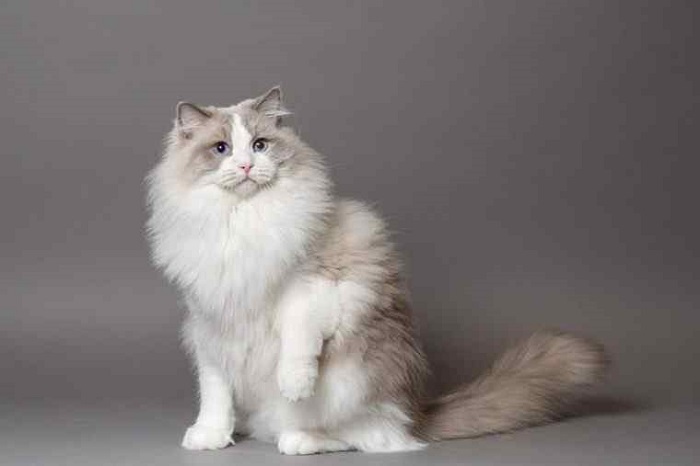The Ragdoll cat is a domestic cat known for its striking appearance, affectionate nature, and tendency to go limp or “go ragdoll” when picked up. Ragdolls are famous pets due to their striking appearance and affectionate personality. However, it’s important to note that individual cat behavior can vary, and spending time with a specific cat or kitten is always recommended to ensure they are a good fit for your home and lifestyle.
Origin and History of Ragdoll Cat
The Ragdoll cat breed was developed in the 1960s by Ann Baker, who lived in Riverside, California, USA. A mix of fact and folklore surrounds the breed’s history. According to the accepted origin story, the breed began with a white female cat named Josephine, owned by Ann Baker.
Josephine was a semi-feral cat of unknown ancestry but had striking blue eyes and a gentle temperament. Ann Baker observed that Josephine had unique traits, such as going limp when picked up, and she decided to breed her to create a new breed with these desirable characteristics.
The breeding program focused on selecting cats with specific traits, including large size, gentle disposition, and relaxed behavior. Several cats of different breeds, such as Persian, Birman, and Burmese, were reportedly used in developing the Ragdoll breed.
Ann Baker named the breed “Ragdoll” because the cat tends to go limp like a ragdoll when held. She established her registry, called the International Ragdoll Cat Association (IRCA), and initially had strict control over the breeding and registration of Ragdolls.
Over time, disagreements and conflicts arose within the Ragdoll breeding community, forming other Ragdoll cat associations. These organizations, such as the Ragdoll Fanciers’ Club International (RFCI) and the Ragdoll Breed Club (RBC), developed separate breed standards and registration guidelines.
Today, the Ragdoll breed is recognized by major cat registries, including The International Cat Association (TICA), the Cat Fanciers’ Association (CFA), and the American Cat Fanciers Association (ACFA). Ragdolls are popular and well-loved for their striking appearance, affectionate nature, and docile temperament.
Physical Features of Ragdoll Cats
The Ragdoll cat is known for its unique and distinctive physical features. Here are some notable characteristics of the Ragdoll breed:
- Size: Ragdolls are a large breed of cat. They have a substantial and sturdy body with a solid bone structure. Adult males typically weigh between 15 to 20 pounds (6.8 to 9.1 kilograms), while adult females generally weigh between 10 to 15 pounds (4.5 to 6.8 kilograms).
- Coat: Ragdolls have a semi-longhair coat that is soft, silky, and plush. The coat is moderately dense and prone to matting. It lies relatively close to the body, with a ruff of longer fur around the neck and a full-plumed tail.
- Color and Patterns: Ragdolls come in a variety of colors and patterns. The accepted colors include seal, blue, chocolate, lilac, flame, and cream. The coat patterns can be pointed, mitted, or bicolor. Pointed Ragdolls have a darker color on their ears, faces, paws, and tail, while the body is lighter. Mitted Ragdolls have white “mittens” on their front paws and often have a white chin, chest, and belly. Bicolor Ragdolls have more extensive areas of white on the body, including a white inverted “V” on the face and white on the chest, paws, and tail.
- Eye Color: Ragdolls have large, expressive, and striking blue eyes. The eye color is intense and vibrant, adding to their overall appeal.
- Body Type: Ragdolls have a semi-cobby body type, meaning they have a sturdy and muscular build. They have a broad chest, a level back, and a medium-length neck. Their legs are medium length, and their paws are large and round.
- Facial Features: Ragdolls have a well-rounded face with gentle contours. They have a slightly rounded forehead, full cheeks, and a medium-length muzzle. Their ears are medium-sized and set wide apart.
Height, Weight, and Lifespan of Ragdoll Cat
The Ragdoll cat breed is known for its larger size than many other domestic cat breeds. Here are the average height, weight, and lifespan of Ragdoll cats:
- Height: Ragdoll cats are not typically measured in terms of height. However, they generally have a medium-to-large body size with a substantial bone structure.
- Weight: Adult Ragdoll cats usually weigh between 15 and 20 pounds (6.8 to 9.1 kilograms). Adult female Ragdolls tend to be slightly smaller, ranging from 10 to 15 pounds (4.5 to 6.8 kilograms). These weight ranges can vary, and individual cats may fall outside them.
- Lifespan: Ragdoll cats have a relatively long average lifespan compared to other cat breeds. On average, Ragdolls live between 12 to 15 years. With proper care, some Ragdolls have been known to live into their late teens or even early twenties.
Colors of Ragdoll Cat
Ragdoll cats come in a variety of colors and patterns. The accepted colors recognized by significant cat associations, such as The International Cat Association (TICA), the Cat Fanciers’ Association (CFA), and the American Cat Fanciers Association (ACFA), include the following:
- Seal: This color is a dark brown that can range from warm to cool tones.
- Blue: Blue Ragdolls have a bluish-gray coat, often with a silver cast.
- Chocolate: Chocolate Ragdolls have a rich, warm brown color.
- Lilac: Lilac Ragdolls have a lighter, pale grayish-pink coat.
- Flame: Flame Ragdolls, also known as red or orange, have a warm reddish coat.
- Cream: Cream Ragdolls have a lighter flame color with a pale cream coat.
In addition to these base colors, Ragdolls can exhibit various coat patterns. The three recognized patterns are:
- Colorpoint: This pattern features darker coloration on the ears, face, paws, and tail, with lighter body color.
- Mitted: Mitted Ragdolls have a colorpoint pattern and white “mittens” on their front paws. They often have a white chin, chest, and belly.
- Bicolor: Bicolor Ragdolls have more significant areas of white on their body, including a white inverted “V” on the face and white on the chest, paws, and tail. The white areas contrast with the darker color on the rest of the body.
The Behavior and Temperament of Ragdoll Cats
The Ragdoll cat breed is known for its gentle and docile temperament. Here are some expected behavior and temperament traits associated with Ragdoll cats:
- Affectionate and Social: Ragdolls are known for their affectionate nature. They often seek out human companionship and enjoy being near their owners. They are often described as “lap cats” and enjoy cuddling and being held. They often form strong bonds with their human family members.
- Relaxed and Laid-Back: Ragdolls are known to be a calm and easygoing breed. They tend to be relaxed and are not typically as active or high-strung as other breeds. Ragdolls may have moments of playfulness, but they generally have a more laid-back approach to life.
- Tendency to Go Limp: One unique behavior trait of Ragdolls is their tendency to go limp or “go ragdoll” when picked up or held. This behavior is where the breed gets its name. Ragdolls have a more relaxed muscle tone and may go completely limp in their owner’s arms, making them easier to handle.
- Sociable with Humans and Other Pets: Ragdolls are typically friendly and sociable with humans and other pets. They often get along well with children and are known for their patience and tolerance. Ragdolls can coexist peacefully with other cats or dogs if properly introduced.
- Gentle and Soft-Spoken: Ragdolls are generally gentle cats. They are not known for being overly vocal or demanding attention. They have a soft, sweet voice and are known for their soft purrs.
- Adaptive and Well-Suited for Indoor Living: Ragdolls are generally well-suited for indoor living. They adapt well to apartment living or homes without outdoor access. Due to their trusting nature and lack of territorial solid instincts, they are typically best kept indoors to protect them from potential dangers.
Food and Nutrition of Ragdoll Cat
Proper nutrition is essential for the health and well-being of your Ragdoll cat. Here are some considerations when it comes to the food and nutrition of Ragdoll cats:
- Balanced Diet: Provide a balanced and complete diet specifically formulated for cats. Look for high-quality commercial cat foods that meet the nutritional requirements of recognized cat food organizations, such as the Association of American Feed Control Officials (AAFCO).
- Wet or Dry Food: Both wet and dry cat food options can suit Ragdolls. Wet food can help ensure adequate hydration, while dry food can help maintain dental health. Some cat owners feed a combination of both to provide variety and meet their cat’s preferences.
- Protein: Cats are obligate carnivores, so their diet should contain a high proportion of animal-based protein. Look for cat foods that list a quality source of protein, such as chicken, turkey, or fish, as the primary ingredient.
- Avoid Fillers and Artificial Additives: Avoid cat foods that contain excessive fillers, by-products, or artificial additives. These ingredients may be less nutritionally beneficial and can lead to digestive issues or allergies in some cats.
- Controlled Feeding Portions: Ragdolls tend to overeat, leading to weight gain and potential health problems. It’s crucial to provide controlled feeding portions and avoid free feeding. Follow the recommended feeding guidelines on the cat food packaging and consult your veterinarian for specific dietary recommendations based on your cat’s age, weight, and activity level.
- Monitor Weight and Adjust Diet: Keep an eye on your Ragdoll’s weight and body condition. If your cat starts gaining weight or becoming overweight, consult your veterinarian to adjust the diet and feeding portions accordingly.
- Fresh Water: Always provide fresh, clean water for your Ragdoll cat. Cats have a low thirst drive, so ensuring easy access to water can help prevent dehydration.
- Consult with a Veterinarian: Your veterinarian can provide specific dietary recommendations tailored to your Ragdoll cat’s needs. Regular veterinary check-ups can help monitor your cat’s health and address nutritional concerns.
Care and Management of Ragdoll Cats
Proper care and management are crucial for the well-being of your Ragdoll cat. Here are some key considerations to keep in mind:
- Veterinary Care: Schedule regular check-ups with a veterinarian to ensure your Ragdoll cat’s health. Routine vaccinations, parasite control, dental care, and preventive screenings are essential to maintain overall well-being.
- Grooming: Ragdolls have a semi-longhair coat that requires regular grooming to prevent tangles and matting. Brush your Ragdoll cat at least a few times a week to remove loose hair and prevent the formation of mats. Regular nail trims and dental care are essential for their grooming routine.
- Litter Box Maintenance: Provide a clean and easily accessible litter box for your Ragdoll cat. Scoop the litter box daily and replace the litter regularly to maintain good hygiene and prevent litter box aversion.
- Environmental Enrichment: Provide a stimulating environment for your Ragdoll cat. This includes offering scratching posts, climbing trees or shelves, interactive toys, and play sessions to keep them mentally and physically active. Ragdolls enjoy interactive playtime with their owners, as it helps strengthen the bond between the cat and their human companions.
- Indoor Living: Ragdolls are typically better suited to an indoor lifestyle. This helps protect them from potential dangers such as traffic, predators, and diseases. Ensure your home environment is safe, providing ample exercise, exploration, and mental stimulation opportunities.
- Diet and Nutrition: Feed your Ragdoll cat a balanced and appropriate diet to maintain their health and weight. Choose high-quality cat food formulated for their life stage and specific needs. Monitor their weight and adjust the feeding portions as necessary to prevent obesity.
- Socialization and Attention: Ragdolls are social cats and enjoy human companionship. Spend quality time interacting and playing with your Ragdoll cat to fulfill their social needs. Ragdolls are generally good with children and other pets, but introduce them gradually and under supervision to ensure a positive and safe interaction.
- Safety Measures: Take necessary precautions to ensure your Ragdoll cat’s safety. Keep hazardous substances out of their reach, secure windows and balcony areas, and provide a secure and supervised outdoor enclosure if you choose to give them limited access to the outdoors.
The Health of Ragdoll Cat
Ragdoll cats are generally considered to be a healthy breed with no specific breed-related health issues. However, like all cats, Ragdolls can still be susceptible to specific health conditions. Here are some health considerations for Ragdoll cats:
- Hypertrophic Cardiomyopathy (HCM): HCM is a heart condition can affect Ragdoll cats and other breeds. It involves the thickening of the heart muscle, which can lead to heart function abnormalities. Regular veterinary check-ups, including cardiac screenings, can help monitor the heart health of Ragdoll cats.
- Polycystic Kidney Disease (PKD): PKD is an inherited condition that can lead to the development of cysts in the kidneys. While PKD is less common in Ragdoll cats than in other breeds, awareness of the potential risk is still essential. Responsible breeders often test their breeding cats for PKD to help reduce the incidence of the disease.
- Urinary Tract Issues: Ragdolls can be prone to certain urinary tract issues, such as bladder stones or infections. Providing fresh water, a balanced diet, and ensuring proper litter box hygiene can help reduce the risk of these issues. If you notice any signs of urinary discomfort, such as frequent urination or straining, it’s important to consult with a veterinarian.
- Obesity: Ragdolls tend to gain weight if overfed or not given enough exercise. Obesity can lead to various health problems, such as diabetes, joint issues, and decreased quality of life. Monitoring your Ragdoll’s weight, providing a balanced diet, and encouraging regular exercise are essential for maintaining a healthy body weight.
- Dental Health: Like many cats, Ragdolls can be prone to dental issues such as periodontal disease and tartar buildup. Regular dental care, including tooth brushing and routine veterinary dental cleanings, can help maintain good oral health.
- General Care: Proper nutrition, regular veterinary check-ups, a safe environment, and attention to their overall well-being are essential for keeping Ragdoll cats healthy. This includes preventive measures such as vaccinations, parasite control, and monitoring for any signs of illness or discomfort.
Fun Facts on Ragdoll Cats
Certainly! Here are some fun facts about Ragdoll cats:
- Ragdolls are often referred to as “puppy cats” because they exhibit some dog-like behaviors. They may follow their owners around the house, greet them at the door, and even play fetch.
- Ragdolls tend to go limp when picked up, a behavior known as “ragdolling.” This relaxed and floppy response is unique to the breed and adds to its charm.
- Ragdolls are typically not fully mature until around three to four years of age in terms of physical size and coat development. They are considered a slow-maturing breed.
- Ragdolls are excellent companions and are often described as “dog-like” in their loyalty and devotion to their owners. They enjoy being near their humans and are known to be very social cats.
- Ragdolls are generally good with children and other pets. Their gentle nature and calm temperament make them well-suited for multi-pet households.
- Ragdolls come in various colors and patterns, including seal, blue, chocolate, lilac, flame, and cream. They can also have different coat patterns, such as colorpoint, mitted, or bicolor.
- Ragdolls have captivating blue eyes, one of their most striking features. The intensity of their eye color is typically seen in the pointed color pattern, but it can vary slightly depending on the individual cat.
- Ragdolls are known to enjoy being held and cuddled. They often seek out laps and love to be a part of their owner’s activities, making them excellent companions for those seeking a loving and affectionate cat.
- Ragdolls have a soft and silky coat, which is relatively low-shedding compared to other longhaired breeds. Regular grooming helps maintain their coat in good condition and minimizes shedding.
- Ragdolls are relatively quiet cats and tend to have a soft and sweet voice. While they may not be as vocal as some other breeds, they can still communicate their needs and desires through their body language and subtle vocalizations.
These fun facts highlight some delightful qualities that make Ragdoll cats beloved pets. Their gentle nature, striking appearance, and affectionate personality have earned them a special place in the hearts of cat lovers worldwide.
Ragdoll Kitten For Sale
However, if you’re interested in finding a Ragdoll kitten for sale, there are a few options you can explore:
- Reputable Breeders: Look for reputable Ragdoll cat breeders who follow ethical breeding practices. They typically provide their cats with a clean and healthy environment, perform necessary health screenings, and socialize their kittens. You can search online or contact cat breed associations or clubs for breeder referrals.
- Cat Adoption Centers or Shelters: Check local cat adoption centers or animal shelters, as they may occasionally have Ragdoll cats or Ragdoll mixes available for adoption. Adopting a cat can be a rewarding experience and provides a loving home to a cat in need.
- Ragdoll Rescue Organizations: Some organizations specialize in rescuing and rehoming Ragdoll cats. They may have Ragdoll kittens available for adoption. Research Ragdoll-specific rescue organizations or contact general cat rescue groups to inquire about Ragdolls in their care.
When acquiring a Ragdoll kitten, it’s essential to research the breeder or organization thoroughly, ask questions about the kitten’s health and lineage, and visit the facility if possible. Ensure the kitten receives appropriate vaccinations, deworming, and veterinary care before adoption.
Final Talk on Ragdoll Cat
Ragdoll cats are a beloved and unique breed known for their gentle nature, striking appearance, and affectionate personality. Ragdoll cats make excellent companions and are cherished for their calm and loving nature. Whether looking for a cuddly lap companion or a gentle and pleasant pet, a Ragdoll cat can be a great choice. Remember to give them proper care, attention, and love to ensure a happy and healthy life together.
